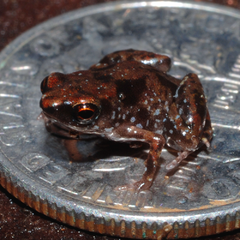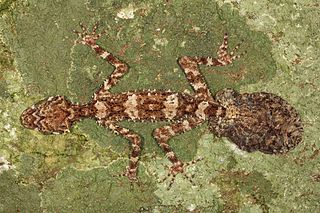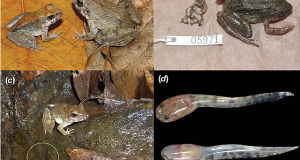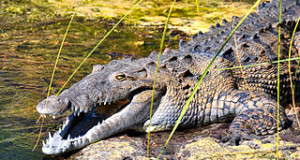Not a week – much less a year – passes without an exciting new herp species being discovered. Included among this year’s surprising finds are the world’s smallest vertebrate, geckos and frogs isolated on mountaintops for millions of years, a “political” snake, and legless lizards living in and near major US airports and cities. Please also check out the linked articles to read about large, colorful monitor lizards and other awe-inspiring creatures that were brought to light in the past few years. Following is just the tip of the iceberg…please be sure to post your own favorite finds below.
New Reptile and Amphibian Species in 2013
The World’s Smallest Vertebrate
The distinction of being the smallest creature with a backbone generally shuffles between frogs and fishes (the world’s smallest snake, which can coil up on a dime, is also very impressive). This year, a tiny Southeast Asian fish that held the title since 2006 was nudged out by a Microhylid frog, Paedophryne amanuensis (shown here sitting on a dime, with room to spare!). Endemic to Papua New Guinea, adults can be as small as 0.28 inches, while the largest individuals barely top 0.3 inches. But packed into their minute bodies are lungs, a brain, liver and all other such organs (they do have a uniquely-reduced skeleton, however – compromises must be made!). By contrast, the Blue Whale, world’s largest vertebrate, tops out at approximately 90 – 100 feet in length.
The “No-To-The-Mine” Snake, Sibon noalamina
Apparently restricted to mountainous rainforests in a tiny section of western Panama, this secretive snake consumes a highly-specialized diet. Like most of its relatives, it searches moist leaf litter for snails, slugs, frog and salamander eggs and, perhaps, earthworms. Unfortunately, it is already facing an uncertain future, as iron ore mining may destroy its only habitat. It was named in support of local people who oppose further destruction of their traditional homeland.
Millenniums in Isolation
Australia’s land and wildlife has been fairly well-studied, but not so a mountain top on the tropical northeastern tip of Queensland. Dubbed the “lost world” by researchers, the site is covered by millions of huge black granite boulders. Living among the boulders in this other-worldly environment are three (at least, I’m sure!) previously unseen herps – each of which has been isolated from their closest relatives for millions of years.
The 8-inch-long Cape Melville Leaf-Tailed Gecko, Saltuarius evimus, hunts by night, when it hangs head-down on rock-faces, awaiting passing invertebrates. A slender body allows it to hide among boulder crevices by day.
The Blotched Boulder Frog, Cophixalus petrophilus, spends the dry season deep within boulder piles – truly a “lost world within a lost world”. What goes on there, and whether it aestivates or feeds upon resident invertebrates, is unknown. Its tadpoles develop within eggs deposited on land and guarded by the male, and hatch out as tiny froglets.
Golden-hued and active by day, the Cape Melville Shade Skink, Saproscicus saltus, has adapted to life among the boulders by evolving a most “un-skink-like” ability to hop.
Amazonian Frogs and Lizards
The Amazon Basin’s 2.1 million square miles encompasses portions of 9 countries, and contains over ½ of the world’s remaining rainforests. It may also be the most species-rich habitat on earth. In the past 3 years (2010-2013), a staggering array of new species have found there, including 58 amphibians, 22 reptiles, 258 plants, at least 3 mammals, and 18 birds. The area’s invertebrate diversity requires separate attention…look for an article in the near future.
My favorite reptilian surprise is the War Paint Lizard, Gonatodes timidus. The species name of this dwarf gecko refers to its shy nature which, along with a restricted habitat, has rendered it unseen until this year. Apparently confined to central Guyana, the War Paint Lizard is quite a beauty. The black head of the male is marked with brilliant yellow or white blotches, and the throat is bright reddish-orange or golden in color.
The tiny, aptly-named Thimble Frog, Allobates amissibilis, is found only on central Guyana’s Wokrama Mountains. Planned tourist facilities may threaten its future survival.
Urban Lizards
California’s legless lizard diversity jumped from a single species to five this year. Four new species (genus ) were found by herpetologists who laid-out thousands of boards in the hope that something interesting would seek shelter below…they were surprised but not disappointed!
The Southern California Legless Lizard was first discovered at the west end of Los Angeles International Airport; later it was also found in nearby sand dunes. A vacant lot in downtown Bakersfield, CA, the oil fields of Taft, CA, and canyons at the Mojave Desert’s edge yielded 3 additional new species. Due to their small size and secretive ways, the western USA’s legless lizards have not been well-studied…I’m sure we’re in for more surprises, now that the species hunters’ appetites have been whetted!
Further Reading
 That Reptile Blog – Reptile, Amphibian and Exotic Pet Care and Information
That Reptile Blog – Reptile, Amphibian and Exotic Pet Care and Information






